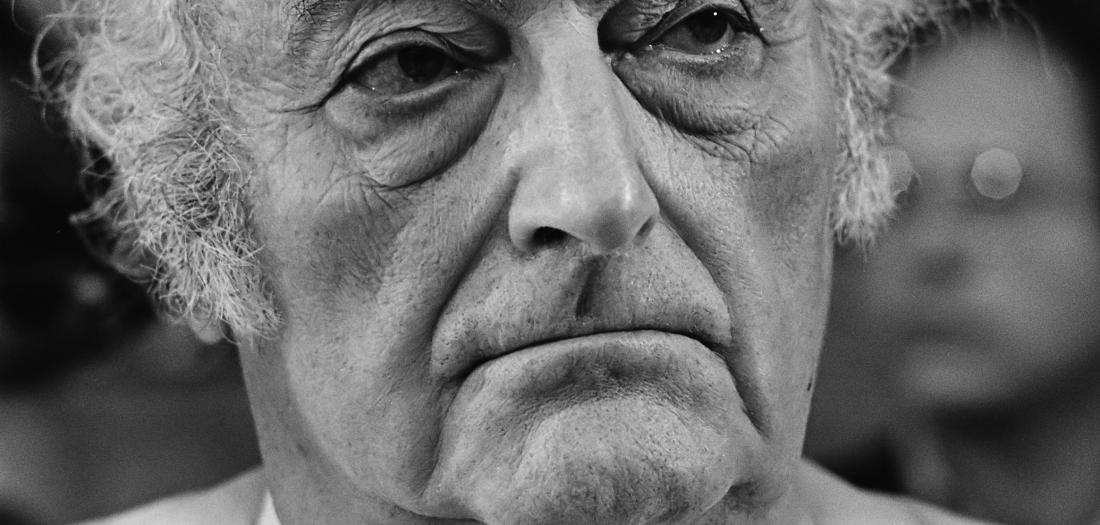Stefan Heym's “Ahasver” in a Digital Edition
Three-year Pilot Project of the Trier Center for Digital Humanities and the TU Chemnitz on a Digital Historical-Critical Edition is Launched
11.05.2021 | Press Releases, Project News

“Haagse Treffen”, a European conference for writers in the Kurhaus in Scheveningen; Stefan Heym, by Marcel Antonisse / Anefo - Nationaal Archief
Life and Work of Stefan Heym
Born and raised in Chemnitz as the son of a Jewish merchant, the writer Stefan Heym (1913-2001) is one of the cultural beacons of the city of Chemnitz. Although Heym's journalistic-literary, social and political life was and still is of great relevance, his oeuvre has surprisingly been rather neglected so far. In contrast, many works of other renowned authors of the 20th century have already been catalogued comprehensively or are at least partially available in annotated-critical editions. In Chemnitz, the “International Stefan Heym Society”, the “Chemnitz City Library” (where the Stefan Heym Forum with the author's working library was recently opened) as well as the professorship "Modern German and Comparative Literature" of the Chemnitz University of Technology are particularly concerned with the cultivation of his work, which radiates far beyond the borders of Germany. Now, the holder of the professorship, Prof. Dr. Bernadette Malinowski, and her colleague, PD Dr. Christoph Grube, in cooperation with the managing director of the Trier Center for Digital Humanities (TCDH), Dr. Thomas Burch, were able to acquire funds from the German Research Foundation (DFG) for a research project entitled “Stefan Heym: 'Ahasver' - Pilot Project on a Digital Historical-Critical Edition.”
The Novel “Ahasver”
The pilot project consists of a digital historical-critical and annotated edition of the novel “Ahasver”. First published in 1981, the narrative text formulates a counter-proposal to the legend-like tradition of the 'eternal Jew' Ahasver. In Heym's alternative interpretation, Ahasver appears not as a religiously motivated traitor to Christ, but as an angel with the historically this-worldly message of a world improvement through human action. The novel, which is set on three time levels (one takes place shortly after Creation, one in the Reformation period and one in the years 1979-1981), is no longer easily comprehensible for today's readers because of its intertextual references and its numerous contemporary allusions, e.g., to GDR conditions. In his lifetime, Stefan Heym donated his collections of materials, his preparatory work and manuscripts to the archives of the Cambridge University Library, where approximately 5,000 pages of material on "Ahasver" are now being digitally photographed, thus, creating the conditions for preparing the estate for a digital historical-critical edition and making it available to a broad public for the first time in open access. Supporters of the project are Inge Heym, the author and publicist's widow, Sebastian Ritscher, Stefan Heym's literary agent, the board of the International Stefan Heym Society and Thomas Rathnow, CEO of Verlagsgruppe Random House. Rathnow emphasizes: “Without their placet, especially the agreement of Mrs. Heym, we would not have been able to tackle this project. Of course, we very much hope that this project, funded for a period of three years, will be the prelude to a future complete edition of Stefan Heym's literary and journalistic works. However, we don't even dare to think that far yet, especially since this always involves difficult copyright issues.”
Globally Available, Searchable and Multi-perspective
The project benefits in particular from the TCDH's longstanding participation in the project “Arthur Schnitzler digital (ASd)”. The strategies developed here for marking the material properties of the surviving documents, for modeling the history of the creation of the work and for recording writing processes can be transferred to the Heym edition. Thus, the position of handwritten additions and changes on the text carrier is just as much an element that carries meaning and must be marked accordingly as the recording of the text topography and its assignment to genetic text stages and correction layers. For the Heym Edition, therefore, systems that have proven themselves in digital edition projects, such as the virtual research environment “FuD”, the interactive transcription tool “Transcribo” or the collation environment “Comparo” are used. These tools, developed by the TCDH team, offer a wide range of functionalities for transcription and data acquisition, annotation, analysis as well as preparation up to publication and archiving. With regard to the online publication of research results, proven concepts and technologies of modern web applications, as developed by the TCDH, are also used to ensure the longevity of digital publications. The result is a digitally searchable and multi-perspective edition of Stefan Heym's novel “Ahasver” that is available worldwide and at any time.
Further information: Dr. Thomas Burch

